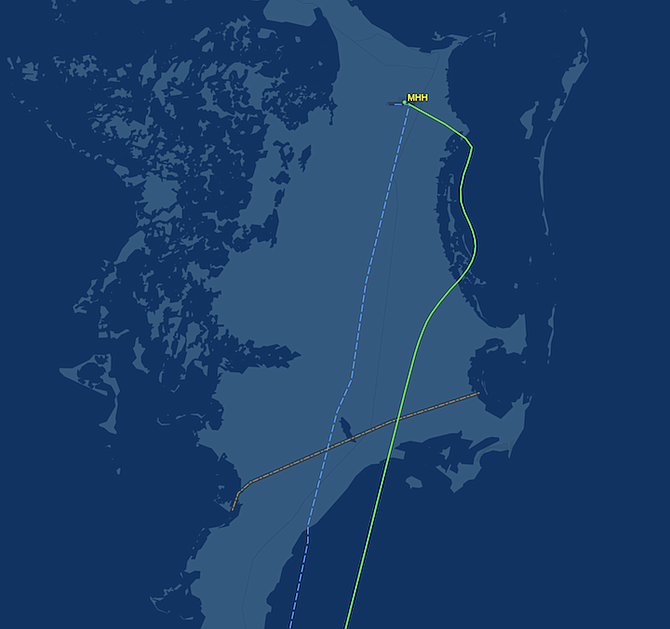A flight path map showing the plane’s sudden turn to the left after it departed from Marsh Harbour airport. (flightaware.com)
PASSENGERS were left terrified after being involved in a near mid-air collision on a Bahamasair flight out of Abaco.
Flight UP236 had just taken off 10 minutes earlier than scheduled from Marsh Harbour airport last Thursday when it suddenly had to bank steeply and make a rapid descent.
Businessman Adam Darville was among those on board.
He told The Tribune yesterday: “I was returning to Nassau after spending the holiday with family in Green Turtle Cay.
“At Marsh Harbour airport I’d noticed how busy the landing strip was with small planes coming in seemingly every other minute. I can’t recall seeing it that busy so it was a bit surprising when we got the call saying we were taking off a little bit early.
“Everything was normal on take off and I was just resting back in my seat when there was a sudden lurch to the left and the plane seemed to nose down.
“I was physically pulled out of my seat by the manoeuvre and had to grab the chair in front and push myself back down into my seat.”
Other passengers, said Mr Darville, were completely traumatised by the event.
“There were a few screaming and saying prayers,” he said.
“One woman next to me was completely out of it – just staring ahead clearly fearing the worst.
“We seemed to be just heading straight down but then the situation calmed down as the plane levelled out and began its climb once again.
“After about five minutes the captain came on over the intercom and calmly explained what had happened. He said another plane had strayed too close to us and he’d had to take evasive action.
“The rest of the flight was really uncomfortable as everyone was on edge. Every bit of turbulence had everyone on edge.”
The incident once again highlights the dangers inherent in flying around The Bahamas without proper air traffic control in place.
For many years local pilots have followed a General Aviation Rule which gives them sole responsibility for take off and landings and for movement below 10,000 feet.
The pilot of the Bahamasair flight Mr Darville was on would have transmitted by radio his movements every two minutes to alert other planes in the vicinity that he was about to leave Marsh Harbour heading for Nassau.
The problem arises if another pilot is not tuned into his frequency or is unaware of the local General Aviation Rule.
One local pilot told The Tribune: “What may have happened here is a plane was flying east or west across the Bahamasair’s flight path and just didn’t know the plane was heading his way.
“The Bahamasair pilot actually was clearly on the ball to make sure his aircraft came through safely.
“Before Dorian the air traffic control tower at Marsh Harbour would have been there to assist but that’s not back in operation yet so pilots are pretty much on their own, relying on others to follow the General Aviation Rules (GAR).
Bahamasair managing director Tracy Cooper said the pilot of the flight involved in the Marsh Harbour incident would not have had to rely solely on his own initiative to avoid another aircraft.
“All our aircraft have a Traffic Collision Avoidance System which is standard for all commercial airlines,” said Mr Cooper.
“If you are flying on any course where another airplane is near it will tell the pilot what to do to ensure there is not a collision. That along with radar and radio and pilots talking to each other should keep the plane in a safe condition.”
BACSWN - Bahamas Aviation, Climate and Severe Weather Network - has developed a first-of-its kind system which would vastly improve weather and other aviation services for aircraft operating in The Bahamas.
Its very advanced aviation system can work in conjunction with terminal air traffic control (i.e taxi, take off, climb, descent, approach and landing portions of flight).
The company had been in extensive talks with the Minnis administration to install the system but an agreement, which was scheduled for signing, was postponed at the last minute until after the general election. Bahamasair managing director Tracy Cooper said that if BACSWN had been in place the pilot of the flight involved in the Marsh Harbour incident would not have had to rely solely on his own initiative to avoid another aircraft.
“All our aircraft have a Traffic Collision Avoidance System which is standard for all commercial airlines,” said Mr Cooper.
“If you are flying on any course where another airplane is near it will tell the pilot what to do to ensure there is not a collision. That along with radar and radio and pilots talking to each other should keep the plane in a safe condition.”





Comments
Bonefishpete 2 years, 3 months ago
Big sky little airplanes works 99.99%of the time.
DWW 2 years, 3 months ago
maybe they should keep their AIS active. heard the tanker had no AIS. bananasair stopped turning theirs on years back. correct me if i am wrong
pileit 2 years, 3 months ago
You don't know what you're talking about, yet still you opine. A symptom of the foolish.
Bonefishpete 2 years, 3 months ago
When in VFR conditions it does help to look out the windscreen.
Bongo 2 years, 3 months ago
Ads-b, required in the US, would help, and also can also provide weather in route.
Sign in to comment
Or login with:
OpenID